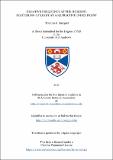Files in this item
Negative frequency at the horizon : scattering of light at a refractive index front
Item metadata
| dc.contributor.advisor | Koenig, Friedrich Ernst Wilhelm | |
| dc.contributor.author | Jacquet, Maxime J. | |
| dc.coverage.spatial | 191, xxxii p. | en_US |
| dc.date.accessioned | 2017-10-02T10:56:51Z | |
| dc.date.available | 2017-10-02T10:56:51Z | |
| dc.date.issued | 2017-12-07 | |
| dc.identifier.uri | https://hdl.handle.net/10023/11780 | |
| dc.description.abstract | This thesis considers the problem of calculating and observing the mixing of modes of positive and negative frequency in inhomogeneous, dispersive media. Scattering of vacuum modes of the electromagnetic field at a moving interface in the refractive index of a dielectric medium is discussed. Kinematics arguments are used to demonstrate that this interface may, in a regime of linear dispersion, act as the analogue of the event horizon of a black hole to modes of the field. Furthermore, a study of the dispersion of the dielectric shows that five distinct configurations of modes of the inhomogeneous medium at the interface exist as a function of frequency. Thus it is shown that the interface is simultaneously a black- and white-hole horizon-like and horizonless emitter. The role, and importance, of negative-frequency modes of the field in mode conversion at the horizon is established and yields a calculation of the spontaneous photonic flux at the interface. An algorithm to calculate the scattering of vacuum modes at the interface is introduced. Spectra of the photonic flux in the moving and laboratory frame, for all modes and all realisable increase in the refractive index at the interface are computed. As a result of the various mode configurations, the spectra are highly structured in intervals with black-hole, white-hole and no horizon. The spectra are dominated by a negative-frequency mode, which is the partner in any Hawking-type emission. An experiment in which an incoming positive-frequency wave is populated with photons is assembled to observe the transfer of energy to outgoing waves of positive and negative frequency at the horizon. The effect of mode conversion at the interface is clearly shown to be a feature of horizon physics. This is a classical version of the quantum experiment that aims at validating the mechanism of Hawking radiation. | en_US |
| dc.language.iso | en | en_US |
| dc.publisher | University of St Andrews | |
| dc.rights | Attribution-NonCommercial-NoDerivatives 4.0 International | * |
| dc.rights.uri | http://creativecommons.org/licenses/by-nc-nd/4.0/ | * |
| dc.subject | Hawking radiation | en_US |
| dc.subject | Quantum field theory | en_US |
| dc.subject | Quantum field theory in curved spacetime | en_US |
| dc.subject | General relativity | en_US |
| dc.subject | Event horizon | en_US |
| dc.subject | Black hole | en_US |
| dc.subject | Fibre optics | en_US |
| dc.subject | Nonlinear optics | en_US |
| dc.subject | Nonlinear fibre optics | en_US |
| dc.subject | Mathematical physics | en_US |
| dc.subject | Experimental physics | en_US |
| dc.subject | Optical horizon | en_US |
| dc.subject | Spontaneous emission of light from the vacuum | en_US |
| dc.subject | Stimulated emission | en_US |
| dc.subject | Quantum physics | en_US |
| dc.subject | Quantum electrodynamics | en_US |
| dc.subject | Experimental quantum field physics | en_US |
| dc.subject | Unruh | en_US |
| dc.subject | Few-cycle laser pulses | en_US |
| dc.subject.lcc | QC174.52V33J2 | |
| dc.subject.lcsh | Quantum field theory | en |
| dc.subject.lcsh | Quantum electrodynamics | en |
| dc.subject.lcsh | Nonlinear optics | en |
| dc.subject.lcsh | Fiber optics | en |
| dc.title | Negative frequency at the horizon : scattering of light at a refractive index front | en_US |
| dc.type | Thesis | en_US |
| dc.contributor.sponsor | Engineering and Physical Sciences Research Council (EPSRC) | en_US |
| dc.contributor.sponsor | University of St Andrews. 600th Anniversary Scholarship | en_US |
| dc.type.qualificationlevel | Doctoral | en_US |
| dc.type.qualificationname | PhD Doctor of Philosophy | en_US |
| dc.publisher.institution | The University of St Andrews | en_US |
The following licence files are associated with this item:
This item appears in the following Collection(s)
Except where otherwise noted within the work, this item's licence for re-use is described as Attribution-NonCommercial-NoDerivatives 4.0 International
Items in the St Andrews Research Repository are protected by copyright, with all rights reserved, unless otherwise indicated.


